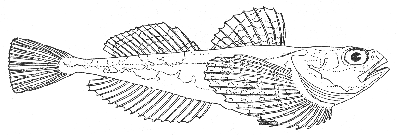Staghorn sculpin Gymnocanthus tricuspis (Reinhardt) 1832
[Jordan and Evermann, 1896-1900, p. 2008.]

Figure 235.—Staghorn sculpin (Gymnocanthus tricuspis). After Smitt.
Description—
This sculpin is easily distinguishable from its more common relatives by the shape of the uppermost of its three cheek spines, which is broad, flat, and with three short, sharp branches at its tip[1] instead of cylindrical and single pointed; also its anal fin (16 to 18 rays) originates well in front of its second dorsal fin instead of behind the latter, and its two dorsal fins are separated by a distinct space instead of being practically continuous at the bottom of the notch that separates them. Furthermore, the spines characteristic of the top of the head and shoulders of our other sculpins are either lacking on the staghorn or are very short, and the corners of its gill covers are rounded instead of sharp. Distinctive also, if less obvious, is the fact that the top of its head is more or less prickly or warty.
The 3-rayed ventral fins reach only about to the vent on young fry of 1¾ to 2 inches, but they [page 453] become relatively longer with growth until at maturity they reach considerably beyond the point of origin of the anal fin, farther in males of breeding age than in females.[2] The first dorsal fin has 11 or 12 spines; the second dorsal 15 to 17 soft rays. The caudal and pectoral fins and the general shape of the fish are of the usual sculpin type.
Color—
Described as dark brownish or gray above, the sides as marked with dark crossbands or with alternate light and dark greenish spots; the lower surface as white or yellowish with an irregular line of demarkation between dark sides and pale belly. The dorsal and pectoral fins are pale, the former with 3, and the latter with 4 or 5 irregular dark brown or black crossbands. The ventral and anal fins are yellow rayed, with membranes of the same color as the belly.
Size—
Up to about 10 inches long.
General range—
Arctic Ocean and North Atlantic, south to northern Norway on the European coast; on the American coast it ranges southward along the outer coast of Labrador[3] to the Gulf of St. Lawrence, where it is generally distributed along the north shore[4] and is characteristic of the icy water on the banks in the southern side, according to Huntsman, and it has been reported as far as Eastport, Maine, as a stray.
Occurrence in the Gulf of Maine—
The most southerly record for this Arctic sculpin, and the only one for the Gulf of Maine, is of a specimen caught at Eastport, Maine, in 1872, and now in the United States National Museum. It is only as a very rare stray from colder waters to the north that it ever reaches our Gulf.
[1] These branches are only faintly indicated at the tips of the spatulate spines on young fry that we have seen, 1¾ to 2 inches long.
[2] Small fry that we have examined from Saeglek Bay on the northeastern coast of Labrador, and an adult male from the estuary of the St. Lawrence River, agree with Smitt's (Scandinavian Fishes, vol. 1, 1892, p. 160 as G. ventralis) account of a specimen from Spitzbergen.
[3] Presumably it also occurs all around the coasts of Newfoundland; but it is not included among the species listed as taken during the trawling cruises of the Newfoundland Fisheries Research Commission.
[4] Stearns, Proc. U. S. Nat. Mus., vol. 6, 1884, p. 125; Kendall, Proc. Portland Soc. Nat. Hist., vol. 2, No. 13, 1909, p. 213-214.